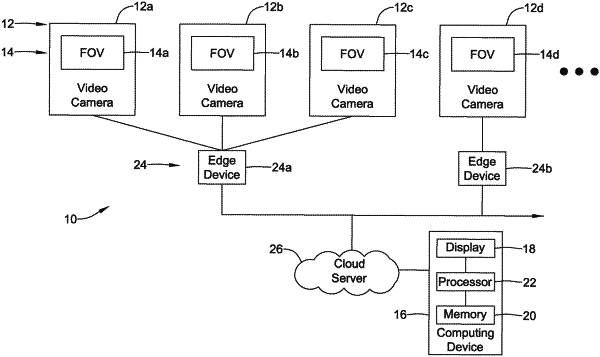| CPC G06V 10/25 (2022.01) [G06T 7/11 (2017.01); G06T 7/62 (2017.01); G06V 20/53 (2022.01); G06T 2207/10016 (2013.01)] | 20 Claims |

|
1. A method of using a computing device having one or more processors to estimate a number of people that are currently present in a region of interest, the region of interest covered by a video camera having a field of view (FOV) that captures the region of interest from a perspective where a person that is closer to the video camera will have a greater size in the FOV than a similarly sized person that is far away from the video camera, the method comprising:
receiving a video stream from the video camera;
analyzing the video stream to detect each of a plurality of people within the region of interest as well as a measure of size consumed by each of the detected plurality of people in the FOV of the video stream, wherein the measure of size is used as an indication of a distance that the corresponding one of the detected plurality of people is from the video camera;
identifying one or more neighbor pairs from among a plurality of possible pairs of the plurality of people within the region of interest, wherein identifying the one or more neighboring pairs includes:
for each of the plurality of possible pairs of the plurality of people within the region of interest, comparing the measure of size consumed by each of the corresponding pair of people in the FOV of the video stream and identifying the corresponding pair of people as possible neighboring pairs when the measure of size consumed by each of the corresponding pair of people in the FOV of the video stream does not differ by more than a threshold amount;
for each of the possible neighboring pairs of people, determining a measure of distance in the FOV of the video stream between the corresponding pair of people, and identifying the corresponding pair of people as one of the one or more neighboring pairs of people when the measure of distance between the corresponding pair of people in the FOV of the video stream is less than a threshold distance, wherein the threshold distance is dependent on the measure of size consumed in the FOV of the video stream by at least one of the corresponding pair of people;
clustering the identified one or more neighbor pairs into one or more clusters;
determining an estimated number of people in each of the one or more clusters, wherein the estimated number of people in each of the one or more clusters is based at least in part on a quantity of the identified one or more neighboring pairs that are associated with the corresponding cluster; and
displaying a representation of the estimated number of people in each of one or more of the clusters on a display.
|